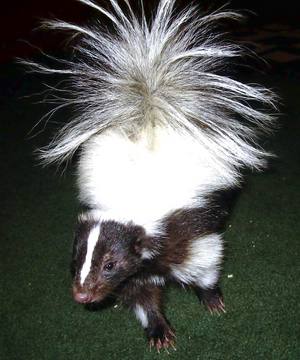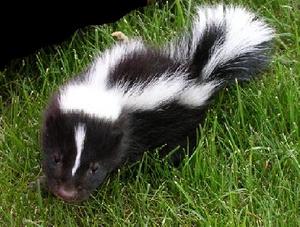Bowser bounds through the door and into your lap carrying an unmistakable odor! It’s [gag] Everywhere! What do you do now?Few odors are more offensive, or lingering, than the defensive spray of the ordinary skunk. Eliminating the odor on pets, furniture and yourself is easy using three common household products, properly combined and applied. Preventing further encounters is also a relatively easy task when you learn a little about the skunk’s habits.
Skunks are quite common in rural, suburban and even some urban settings, making knowing how to eliminate their odor an almost inevitable necessity. Your dogs, cats, children and even you can get hit with their noxious defensive spray that, without treatment, can linger for days. If the event occurred at home, your treatment should include steps to discourage the curious little creatures from taking up residence and making more encounters likely.
Dealing with the odor on yourself and your pet is the first concern and should be attended to immediately. Quick treatment increases the effectiveness on skin, cloth and hair. Just for the record, tomato juice does not work. You and your dog will only end up smelling like spoiled tomato soup. Tomato juice is incapable of breaking down the chemical components of the noxious, oily liquid a skunk produces. It only seems to mask the smell to the user because the nose becomes less sensitive to odors with extended exposure.
A standard formula for killing the scent of a skunk (that makes enough to treat most average to large dogs) is:
1 quart 3% Hydrogen peroxide
1/4 cup baking soda
1 tablespoon liquid dish detergent
shake and use immediately
rinse well and re-apply if needed
I seldom have that amount of hydrogen peroxide available when something like this happens, so I start with what I have and dash to the store after the first round of treatment for more. You can do this using a ratio of 1 tablespoon of baking soda to 1-cup hydrogen peroxide. While I am at the store I also get a bottle of inexpensive tearless baby shampoo to use in place of the liquid detergent. This will allow you to wash your pet’s face (where they usually get hit the worst) better without irritating their eyes.
This will work on your own hair and skin as well, but be warned, it often bleaches or affects the color of hair, particularly color treated locks. Upholstery and clothing should be tested on a hidden area for color stability before full treatment. I have had good results with using a combination of standard 5% solution of white or cider vinegar, baking soda and liquid detergent to machine wash clothing and pillows affected. Mix the soda and vinegar and saturate cloth immediately, this will be foaming and fizzling. Fill the washing machine to the lowest setting of water necessary to saturate and cover load, add the recommended amount of detergent and wash on the longest setting.
Cats are less likely than dogs to have aggressive skunk encounters, they actually seem to get along rather well and have similar natures. It does happen though! Washing a sprayed cat can be like handling an angry buzz saw and I usually just try to rub on some of the mixture (Without the detergent!) using a disposable cloth and leave well enough alone. A few days with food, water and bed outside will take care of the problem even without treatment.
Decks and porches can be affected too. The smell will wear off within a week or so with good ventilation, but if the encounter happened in an enclosed area, treatment may be preferable to the lingering aroma. Liquid bleach at the rate of 1 cup per gallon of water is fairly effective as a spray. (Never use this on pets or skin!) This can bleach some building materials so do test a discrete area first. Try to cover all direct hit surfaces. Areas affected by “drift” will simply need time and air circulation to dissipate.
There are several commercial preparations available that are effective, if a bit pricey. Skunk Off is one usually found in pet supply stores and vet clinics and I can vouch for its effectiveness. These no-wash preparations are a good idea to have along on any camping trip. They are well worth the price because they can prevent contamination of the upholstery in your vehicle by stinky children and pets! You can bag clothing, tent and other affected items, treating them when you get home. I have never tried Skunk Off on a cat, but it seems reasonable that it might be a good solution for the mostly indoor kitty.
If you begin smelling faint skunk aroma around your home on a regular basis it is wise to check for physical evidence. Skunks are nocturnal, making spotting them somewhat difficult. To check for activity safely and easily you will first need to locate their trails.
Loosely stacked woodpiles, materials or brush that provide den type shelter, access to areas under house and porches, along with outdoor pet feeders will encourage skunks to take up residence. Sprinkle a line of flour across suspected entries to possible den areas. Early morning inspection of your flour should tell the tale.
When you have found points of entry to dens you will need to make time for some nocturnal time yourself. Using the flour again, lay a good line across den entries in the late afternoon. An hour or so after sunset, check for tracks leading out of the den. If you see the skunk has left for its nightly rounds, seal all access points to the den. If this is not possible, dousing a one or more rags with straight household ammonia and placing in the doorway, tossing under the house or otherwise fouling their den with will often drive them to more friendly pastures.
Skunks are one of the most common carriers of rabies and a growing population of them can signal the need for stronger action. If you see several sets of tracks, contacting your County agricultural agent, wildlife management office or local animal control officer is a good idea and often preferable to acting on your own. They can assess the situation and provide trapping and relocation service. This can provide a chance for testing and area rabies assessment at the same time.





